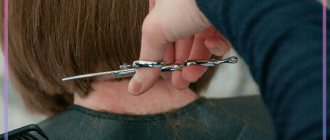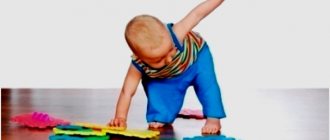Many people have probably heard the sign that you can’t cut a child’s hair under one year old, but not everyone knows where this superstition came from. Perhaps this is partly why it is now customary to turn a blind eye to this ancient custom. Whether this is true or not - everyone decides for himself, but getting acquainted with the history and interpretations of signs is never superfluous. In the end, we are talking about the future fate of the child, who can be harmed by deliberately ignoring the covenants inherited from his ancestors.
Where did superstition come from?
The sign that you cannot cut your hair until you are a year old is based on an ancient Slavic custom. The fact is that in the old days it was customary to distinguish three stages of human development:
- 1 year – tonsure;
- 3-5 years - Lightning for girls and Mounting on a horse for boys;
- 9-12 years old - Twisting for girls and Girdle for boys.
At these milestones, children experience not only physical but also psychological changes. They begin to perceive the world around them, relationships with other people, and themselves in life differently. Hence the importance of how the next stage of development will be met. It was important to correctly introduce a person into society; depending on his gender, girls and boys had their hair cut differently.
In Ancient Rus', newborn children often died. According to popular belief, up to a year they got used to the family and looked closely. If everything suited them, they stayed with their relatives. If not, they died. That is why parents were forbidden to become attached to children under one year old. When the baby reached the age of 1 year, he had his hair cut, recognizing him as a full member of the family. He ceased to be the “property” of the family and became an individual.
Children were introduced into life in different ways. It was customary for boys to have their hair cut bald. Girls, on the contrary, had their hair cut purely symbolically, with baby fluff lightly trimmed at the four cardinal points. This was explained by the fact that hair is associated with the other world, the sixth sense. Boys, future men, came to this world to build new cities and conquer unknown lands. In other words, they needed to learn to think for themselves. The girls, in turn, needed the help of otherworldly forces, as weaker creatures. They needed to develop their intuition in order to maintain harmony in the family and subtly sense the mood of others.
Important! If the hair still got in the way and got into the eyes, on the new moon at 6 months it was allowed to cut the strands that fell on the child’s face.
Arguments for"
Leading pediatric specialists are not inclined to believe folk signs and superstitious fears. Therefore, when parents ask questions about cutting their children’s hair, they often lean toward standard hygiene requirements:
- long hair in a child causes prickly heat;
- since the head sweats more often, this causes discomfort not only for a newborn, but also for an adult;
- It is impossible for a small child to wash his hair often, since even very expensive soap for delicate skin leads to dryness and the appearance of dermatitis;
- pellets on the head due to the thinness and length of the hairs contribute to the appearance of nervousness and crying.
If these facts do not convince you, and an excuse appears: you can constantly comb your child, then it is worth considering that doctors prohibit frequent combing. Pressing a comb on fragile bones will cause more problems in the future than cutting your hair. Any comb leads to damage to the thin baby skin.
Why you can’t cut the hair of children under one year old according to folk wisdom
Violation of an ancient custom is interpreted in different ways. The general negative meaning remains, however, a more precise sign about why you can’t cut a child’s hair up to one year old can be interpreted as follows:
- In Rus', hair was given great importance. They were considered a kind of “channel” that connects a person with the world of higher powers. If this connection is severed before the start of the year, the child’s health can be seriously undermined, since he will be deprived of energy replenishment. The ancestors of the family no longer support him, leaving him alone with illnesses.
- In some regions of Russia, the omen is interpreted in such a way that if you cut a child’s hair before he is one year old, then good luck is cut off along with it. In adult life, he will be unhappy, everything will be difficult for him, and minor troubles will pour in as if from a cornucopia.
- Cutting the hair of small children is a sign of need. In the old days, it was believed that tonsure before a year could bring poverty to a family.
- The pagans had a belief that hair was the center of the human mind. They contained the child’s potential to assimilate folk wisdom. Cutting them before one year means causing learning difficulties for the child. New knowledge will be absorbed much more slowly, the child will not have diligence and patience in learning.
- Also, ancient people associated hair with tongue. According to this interpretation of the custom, it was impossible to cut hair before one year because this would “cut” the baby’s tongue. He might have difficulty communicating in the future. Sometimes children did not start speaking for a long time after getting a haircut at such an early age.
Important! As an exception, it was allowed to cut hair for up to a year at the time of baptism.
About children's hair
Hair on the baby's body appears after the 20th week of pregnancy. In other words, at birth the child already has hair on his head and formed fingernails. The hairs are soft and resemble fluff. They gradually disappear, but new ones immediately appear, thicker than before.
Since matting the first hair leads to uneven length, some moms want to remove it. Others are sure that repeated haircuts lead to thickening of the hair and make the hair thick and luxurious.
But believing that regularly cutting your hair will somehow help correct the genes laid down from conception is a mistake.
The presence of hair depends on family ties. And if there were no people in the family with a lush mustache or thick hair, then no haircut will help make it thicker or longer.
Pediatricians' opinion
The vast majority of doctors do not agree that ancient folk customs have any meaning. In the medical community, it is generally accepted that cutting the hair of a child under one year old will not cause him any harm, both physical and spiritual. On the other hand, even they identify a number of reasons that do not in any way connect a haircut with a loss of luck and happiness in the future, but still warn about the dangers of the procedure:
- Babies have very thin and delicate skin on the scalp, which can be easily damaged by sharp objects.
- On the head of babies there are so-called “fontanelles”, free spaces between parts of the skull that close by the age of one year, or even later. If you press on one of the fontanelles, you can inadvertently cause serious injury to it.
- Young children are very active. They are difficult to keep in place, so cutting hair for up to a year can be quite a dangerous task.
- A child under one year old perceives hair in the same way as he sees his arms or legs - as a full-fledged part of his body. Attempts to cut hair for this reason are often met with tears and hysterics. Sometimes the stress is so strong that it negatively affects the future development of the child.
Advice! If your baby's hair grows too quickly, you can still carefully cut it off before the age of one, but not the entire length. It is advisable to cut only the forehead area so that the hair does not get into the child’s eyes. Otherwise, vision problems may occur.
Suitable age for first haircut
Nowadays, infant mortality is very low compared to pagan times. People's knowledge has changed significantly. Therefore, there are no objective reasons to refuse a haircut at an early age, if it is necessary. At the same time, there is no need to observe any special rituals to protect the child from negativity.
Some parents still follow the rule, postponing the first visit to the hairdresser until 1 year. It is believed that cutting your hair at this age will make your hair thick and strong. This opinion has been scientifically proven wrong. The quality of hairs is determined at the genetic level. It has nothing to do with hair manipulation.
The baby hairs with which a child is born are thin and weak. They resemble fluff in texture. But after a few weeks, the curls begin to grow quickly, disturbing the child. There is no need to wait up to 1 year to shorten unwanted strands. Nowadays a child gets his hair cut if his head sweats, diaper rash appears, and his hair gets tangled. Moreover, it is allowed to take up scissors even at 2-3 months.
You can cut your baby's hair in different ways. Some shorten only the bangs and individual strands that get in the way. Others shave their heads bald. There are also parents who give their young children fashionable hairstyles in a salon. There are no specific rules here. Everything is at the discretion of the parents.
How to avoid the consequences predicted in signs
You can mitigate the negative consequences that the sign predicts if you ignore the ancient custom as follows:
- Using the lunar calendar, it is necessary to determine the date of the new moon. On this day, it is necessary to cut the child's hair, and place the first cut strand of hair in a small bag or box. It is removed away from prying eyes - it is advisable that even close people and friends do not know about the hiding place. The child's hidden hair will serve him as a talisman-amulet. He will protect him from failures, damage and the evil eye.
- Trimmed hair can also be stored in a locket. This way they will protect not only the child, but also the mother.
- In order to return to the child the luck and future well-being lost as a result of a broken tradition, it is necessary to “comb” the baby 3, 9 or 13 times not with a comb, but with coins squeezed between the fingers. In the old days, it was believed that such a procedure attracted wealth.
- If the child's hair was cut before a year, but was preserved, you can also put it in a thick book, carefully placing it between the pages. According to popular beliefs, this little trick not only returns to the baby the mental acuity lost due to the parents’ ignorance, but also increases it.
There is also a completely opposite opinion about whether hair cut off for up to a year or on a child’s first birthday should be kept at home. A strand of children's hair can be used by ill-wishers to damage the baby, so they should be burned or buried in the forest.
Advice! To attract good luck and wealth, a strand is buried in an anthill. A crossroads is also considered a place with powerful energy - you can leave your hair there.
What do the experts say?
It happens that a child’s hairstyle is a topic for intense discussion, in which all adult family members and their acquaintances take an active part. To cut or not to cut, to shave or not to shave is not an easy decision, but it must be made based solely on the benefit for the child. According to pediatricians and trichologists, at no age (neither before one year nor after) a haircut can harm the baby, and even more so his hair - it will not make it any better or worse.
The famous doctor and TV presenter O.E. Komarovsky agrees with this statement and adds that the scale of the problem of cutting young children’s hair is significantly exaggerated by overly proactive grandparents. In fact, there is no dilemma and no problem - if parents see the need to cut their child’s hair, they should do it as often as the situation requires.
Where to put the cut hair? No doctor can answer this question. Official medicine has no facts indicating a connection between hair and human health, well-being, luck and well-being.
How to dispose of or store baby locks does not matter - do as your heart and mind tell you.
Debunking myths
Myth one. A “zero” haircut can affect the growth rate and thickness of hair.
Hair follicles (including those on the head) are formed in utero. There is no way to increase their number by shaving or cutting, head massage, sun or air baths. But it is very easy to damage existing hair follicles. The fact is that in babies, the hair follicles are very close to the surface of the skin, and the skin itself is thin. Shaving, cutting your hair like an adult, and even excessively vigorous combing can damage the hair follicles and lead to skin irritation.
Myth two. If the baby's down is not cut off, the child will be left with thin, sparse hair for the rest of his life.
Such a judgment has no basis. Every child is born with vellus hair, formed in utero. His “hairstyle” at birth can vary from a noticeable “hedgehog” to thick curls. In the period from three months to one and a half years, the vellus falls out and is erased. “real” hair replaces fluff without any additional effort on the part of the parents. A final assessment of the color, structure and thickness of a child’s hair is possible only after reaching 14-15 years of age. During puberty, hair will look the same as it does in adulthood.
Myth 3. If you cut your baby's hair to zero per year, his hair will immediately become stronger, thicker and healthier.
The baby's locks grow unevenly. That is why, after shaving or cutting, the child’s head looks neater and the hair becomes thicker. In reality, the effect is achieved due to the fact that the hair has become shorter and has the same length.











